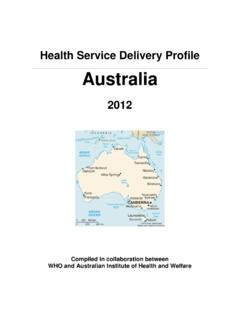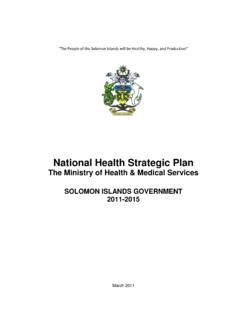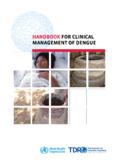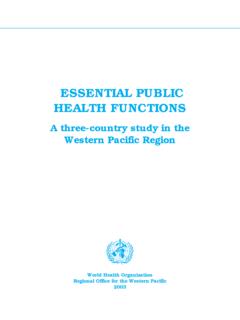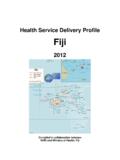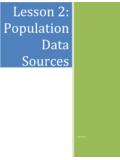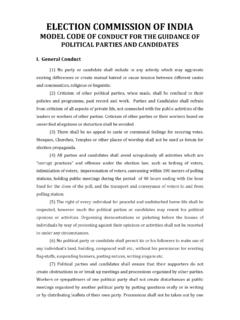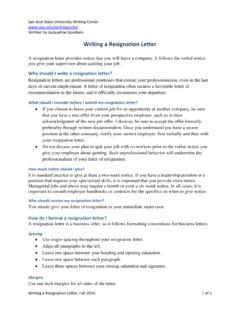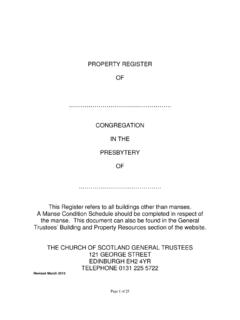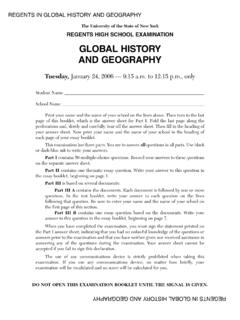Transcription of Health Service Delivery Profile Papua New Guinea
1 Health Service Delivery Profile Papua New Guinea 2012 Developed in collaboration between WHO and the National Department of Health , Papua New Guinea Papua New Guinea Health Service Delivery Profile , 2012 2 Papua New Guinea Health Service Delivery Profile Demographic, socio-economic and Health context Lying just south of the equator, 160km north of Australia, Papua New Guinea (PNG) is part of an arc of mountains stretching from Asia, through Indonesia into the South Pacific, and consists of more than 600 islands. PNG has 19 provinces and the National Capital District in 4 administrative regions. The PNG 2011 census indicates a population of million, with a national growth rate of between 2000 and 2011.
2 It is a young population with under 15 years and over 65 years. It is also a mainly rural population , with in urban areas and 318,000 people ( ) in the capital Port Moresby. The terrain is rugged mountainous and rich cultural diversity with hundreds of ethnic groups and more than 800 indigenous languages. The different cultural societies and clans are explicitly acknowledged in the nation's constitution, which states a wish for traditional villages and communities to remain as viable units of Papua New Guinean society and for active steps to be taken in their preservation. PNG has abundant natural resources (forest, land, fisheries, minerals) and ecosystems, and hosts a unique range of biodiversity.
3 Between 1997-2010, 4 million people were affected by natural disasters with damages estimated at around US$100 million. After being ruled by three external powers since 1884, Papua New Guinea gained its independence from Australia in 1975. Strong growth in the mining and resource sector has led to PNG becoming the seventh fastest-growing economy in the world as of 2011 (IMF). Despite this, the majority of the population still live in traditional societies and practice subsistence-based agriculture. Table 1. Key development indicators in Papua New Guinea Development indicators Measure Year Source Human development index 2011 UNDP Gini coefficient 1996 World Bank.
4 2012 Adult literacy (male , female ) 2009 World Bank. 2012 Population living below the national poverty line (%) 2009 ADB PNG Fact Sheet 2011 Total Health expenditure GDP 2010 World Bank. 2012 Life expectancy at birth 2011 World Bank. 2012 Infant mortality rate 47 per 1,000 live births 2010 ADB, Basic Statistics 2012 Under-5 mortality rate 61 per 1,000 live births 2010 ADB, Basic Statistics 2012 Maternal mortality rate 250 per 100,000 live births* 2008 ADB, Basic Statistics 2012 **R31* HVWLPDWHG 005 WR EH EDVHG RQ WKH 31* 'HPRJUDSKLF DQG +HDOWK 6 XUYH\ Life expectancy is shorter and infant mortality is higher than most neighbouring Pacific countries.
5 Both infant and under-5 mortality have decreased steadily since 1990, but not sufficiently for PNG to meet its MDG 4 which calls for reductions by 2015 in under-5 mortality from 90 (in 2000) to 32 per 1000 live births, and in infant mortality from 64 (in 2000) to 24 per 1000 live births. Maternal mortality is a serious problem in PNG, 53% of births are attended by skilled Health personnel. The leading Health problems are communicable diseases, with malaria, tuberculosis, diarrhoeal diseases, and acute respiratory disease as major causes of morbidity and mortality. PNG has a generalized HIV epidemic, driven predominantly by heterosexual transmission.
6 Care and treatment for people living with HIV have improved significantly since 2006. As with other countries in the Western Pacific Region, NCDs are also on the rise. The incidence of malaria is declining as is the proportion of babies born in hospitals with low birth weight. However, Health improvement has not kept pace with the country s economic growth over the past 10 years. Health strategies, objectives, and legislation The National Health Plan 2011-2020 emphasizes strengthening primary Health care services Delivery and aligns its objectives with the Millennium Development Goals (MDGs). Values stated explicitly include equity, gender and people-centeredness, and the National Health Plan states that increasing Papua New Guinea Health Service Delivery Profile , 2012 3 universal Health coverage and equity in access for the rural majority and the urban poor is the first and most important objective.
7 The National Health Service Standards for Papua New Guinea 2011-2020 outlines a 7-level Health Service Delivery structure and systematically describes a package of Health services and the number, types and mix of staff that should be provided at each level of Health care. The following laws contribute to the regulatory framework for Health system functioning in PNG: Poisons and Dangerous Substances Act (1952); Disaster Management Act (1984); HIV/AIDS Management and Prevention Act (2003); The Public Hospitals (Charges) Act (1972) provides for user fees to be charged at public hospitals. The Organic Law on Provincial Governments and Local Level Governments (1977) devolved the management and Service Delivery of rural Health services from the National Department of Health (NDoH) to the provincial and local governments.
8 The New Organic Law (1995) went further and delegated public spending to the local governments.); The Public Hospitals Act (1994) made hospitals quasi-statutory authorities and had implications for rural Delivery . The National Health Administration Act (1997) intended to provide a framework for coordination between the National Department of Health and provincial authorities, and the Provincial Health Authority Act (2007) provides for establishing a single provincial Health authority to integrate the management of hospital services and rural (primary) Health services , instead of hospitals being managed separately by NDoH and rural Health services by provincial governments.
9 Implementation of the Provincial Health Authority Act (2007) is voluntary has been taken up in three provinces: Milne Bay, Eastern Highlands and Western Highlands. The process is ongoing and impact closely watched. The NDoH has responsibility for setting policies, developing standards and guidelines, procuring pharmaceuticals and medical supplies, surveillance, and managing public hospitals including Port Moresby General Hospital, one psychiatric specialist hospital and provincial hospitals. Provincial and local governments are responsible for funding and Delivery of rural Health services , and implementing all policies and programs according to the set goal and vision of the national government.
10 Health advisors coordinate the Health planning process within the provincial government planning framework. Hospitals have independent management boards that receive and administrate national, local and external finances for their Service Delivery . Service Delivery model and provider network Service Delivery in PNG is mainly provided at government and church Health facilities, funded by a mix of government tax revenues, out-of-pocket payments and donor funds. The central government is responsible for the national referral hospital, one specialist, 4 regional and 16 provincial public hospitals. The majority of Health Service Delivery is carried out by provincial and local governments in rural Health services , including rural hospitals, Health centres, Health subcenters, and aid posts.
